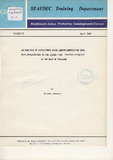| dc.description.abstract | Since the beginning of this century a catch curve, which represents the relationship between the size or age of the fish and the logarithms of the frequency of the occurrence of the fish in catches, has long been recognized as a convenient method of representing the catches graphically and as a useful method of estimating the mortality rate Ricker (1958) . At that time, the method was mostly applied to estimate the mortality rate under the constant mortality with age condition . Not until the middle of the 1960’s was the method developed independently, to make is possible to estimate the mortality rate by iterative method when the fishing mortality varies with age, by Murphy (1965, 1966) for the North Pacific fish and by Gulland (1965, See also his manual published in 1980) for the North Atlantic fish . The common features of these methods are that they require the catches in numbers of various age groups, the natural mortality usually assumed to be constant and the fishing mortality of the older age group. The method has not been widely used, however, because it is tedious and time consuming especially when worked by hand . Pope (1972) developed an ingenious technique which approximates Gulland’s method and this has fish stocks when the fishing and natural mortality rates are less than 1.2 and 0.3 respectively.
The technique, however, relies to a large extent on age information for the catches. This makes it difficult or even impossible to apply to tropical fishes for whom age determination is not as easy as for temperate species and the results of age determination are often unreliable. However recently, Jones (1981)
Made some modifications to Pope’s (1972) technique so that it could be used to estimate the mortality rate based on the length composition data of the catches. This modification has proved to be very useful in working with tropical fishes . But there still exist some weak points which underly Pope’s (1972) approximation i.e. , the fishing mortality and natural mortality rates must be lower than 1.2 and 0.3 respectively.
I have attempted to modify the Gulland-Murphy technique and combine it with the method of estimating the fishing mortality rate from the exploitation and natural mortality rates by iterative method described by Sommani (1972), so that it can be used to estimate the mortality rate from the length composition of the catches . Although the technique is tedious and time consuming, it is my view that at the present time, it is not impossible to carry on the iteration by using a small personal computer or even a small electronic calculator with an algebraic memory mode. | en |

